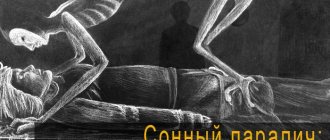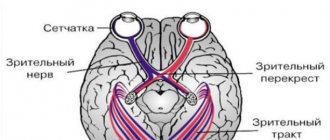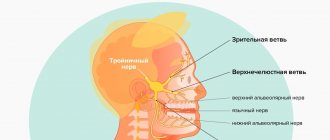- Causes of the disease
- Bell's Palsy Symptoms
- Classification
- At-risk groups
- Diagnostics
- Treatment of Bell's palsy
- Complications
- Rehabilitation and prognosis
Bell's palsy is a pathology that develops as a result of inflammation of the facial nerve, which is responsible for the facial muscles of one half of the face. In this case, sensitivity decreases, muscle weakness develops, and facial movements are difficult. Facial asymmetry becomes pronounced, and problems with the organs of vision begin. The occurrence of Bell's palsy can be associated with prolonged hypothermia, viruses, neoplasms or inflammatory processes. The disease requires treatment and rehabilitation, otherwise persistent asymmetry and complete paralysis may develop.
Causes of the disease
Facial neuritis develops against the background of head injuries and hypothermia. Also the cause of the pathology are:
- infection;
- otitis media;
- herpes;
- parotitis;
- cerebral circulatory disorders;
- previous stroke of ischemic or hemorrhagic type;
- infectious diseases of the brain;
- neoplasms of a benign or malignant nature.
Bell's palsy can occur as a result of a viral infection:
- herpes;
- chicken pox;
- mononucleosis;
- pigs;
- influenza B;
- Coxsackie;
- cytomagalovirus.
A hereditary predisposition is also possible: a narrow bone canal due to anatomical features. In this case, there is a high probability of pinching, especially with inflammatory diseases and circulatory disorders.
Cause of facial neuritis
The cause of Bell's palsy is unknown. However, the most common theory is about the viral etiology of the disease. According to this theory, under certain circumstances, a virus like HSV-1, which usually lives within nerve cells, is activated. The virus begins to actively multiply and produce toxic substances. As a result, inflammation of the nerve occurs and disruption of the conduction of electrical impulses along the nerve fiber. Most patients with sudden loss of facial nerve function on one side are diagnosed with Bell's palsy.
However, this diagnosis must be made by a doctor, such as a neurologist. There are many other causes of facial paralysis. The doctor will look at how quickly the symptoms began, whether there are other symptoms such as fever, headache, hearing loss, dizziness, weakness or numbness in the arms and legs, difficulty swallowing, and hoarseness. The doctor will also need to find out about pre-existing medical conditions, medications, and family history. In addition, a full inspection is required.
Other causes of facial neuritis are: ear infections and tumors, trauma, Lyme disease, brain tumors, stroke, etc.
If the symptoms progressed slowly over 3-6 months, the presence of constant headaches was noted, or there was a transient nature of the symptoms, then this is not Bell's palsy.
The prognosis for neuritis of the facial nerve is quite good. If the dysfunction was incomplete (a certain range of muscle movements was preserved), then the likelihood of a complete recovery is very high. In this case, 95% of patients will have complete recovery of nerve function. In a small number of patients, minor disturbances (asymmetry when smiling or twitching) may persist.
With complete paralysis, it is possible to achieve up to 80% recovery, that is, practical restoration of functions in full. Approximately 17 percent of patients experience persistence of some dysfunction. This may be some weakness of the facial muscles, twitching of the lip or eyelid. A small percentage of patients (4 percent) may have more significant dysfunction, such as persistent facial muscle weakness or twitching.
Typically, most patients begin to regain function within 3 weeks. The earlier recovery begins, the better the final result. If paralysis does not recover within 3 months, then another pathology is likely.
Bell's Palsy Symptoms
The facial nerve is connected to the stapedius muscles of the ear and is responsible for a number of functions: smiling, opening and closing the eyelid, tearing and salivation. With inflammation and damage to the facial nerve, the following manifestations are possible:
- paralysis or paresis of one side of the face;
- difficulty closing one eye;
- irritated mucous membrane of the eye due to lack of blinking;
- drooping of one side of the face, corner of the mouth;
- drooling on one side of the mouth;
- difficult facial expressions;
- change in taste sensations;
- increased sound sensitivity of one ear;
- headache;
- painful sensations in the area of one ear.
Manifestations of Bell's palsy increase gradually. Initially, the patient experiences pain behind the ear; after two or three days, asymmetry occurs: one corner of the mouth droops, the face “skews” to one side, and the nasolabial fold straightens out.
Along with these manifestations, weakness of the facial muscles develops. It is difficult for a person to control his facial expressions; it is impossible to frown, wrinkle his forehead, or smile. There may be a loss of taste, increased tearing, or, conversely, irritation and dryness of the eye.
Depending on the location of the lesion, additional symptoms may occur:
- muscle weakness associated with core damage;
- development of strabismus;
- hearing impairment.
Paralysis
Polio
Encephalitis
Tick-borne encephalitis
Syphilis
Stroke
19190 September 17
IMPORTANT!
The information in this section cannot be used for self-diagnosis and self-treatment.
In case of pain or other exacerbation of the disease, diagnostic tests should be prescribed only by the attending physician. To make a diagnosis and properly prescribe treatment, you should contact your doctor. Paralysis: causes of occurrence, what diseases it occurs with, diagnosis and treatment methods.
Definition _
Paralysis is a complete loss of movement in one or more parts of the body, loss of muscle strength in a muscle or group of muscles, and inability to perform movements. In some cases, the term is used to describe muscle contractility disorders. Paralysis is not an independent disease, but only one of the symptoms of many organic pathologies of the nervous system.
A condition in which voluntary movements are not completely lost is called paresis.
Types of paralysis
Any damage to the nervous system can lead to impaired motor function. There are organic, functional and reflex paralysis.
Organic paralysis is formed due to the fact that the nervous system (at any level) is affected by tumors, injuries, infections or any other factors.
Functional paralysis in most cases occurs as a result of the formation of a so-called stagnant region of inhibition in the brain, which prevents the muscles from receiving the command to contract. During the development of the disease, no pathological changes occur, reflexes remain normal, muscle tone is maintained at the proper level. Reflex paralysis is caused by damage to the peripheral motor neuron and can be caused by damage to any part of the nerve pathway. From an anatomical point of view, a distinction is made between paralysis caused by damage to the central nervous system (brain or spinal cord) and paralysis associated with damage to the peripheral nerves.
The variety of causes of paralysis is reflected in pathomorphological changes, which can have a very different nature and location.
Paralysis is divided according to severity, persistence and prevalence. It can be complete or partial, irreversible or transient, localized or widespread.
None of these clinical types is an independent pathology, however, there are certain types of paralysis that represent independent diseases. These include Parkinson's disease (shaking palsy), polio (infantile paralysis), Bell's palsy, bulbar palsy, pseudobulbar palsy, familial periodic paralysis, brachial plexus palsy, cerebral palsy and others.
Destruction, degeneration, inflammation, formation of foci (plaques), sclerosis, demyelination are the most typical types of pathological changes in nervous tissue that are detected during paralysis. According to their development, acute and flaccid paralysis are distinguished. In the first case, the symptoms increase very quickly, in the second, immobilization develops gradually.
The following classification of paralysis is distinguished, based on the prevalence of the process:
- monoplegia - paralysis of one limb on one side of the body;
- paraplegia - paralysis of two limbs of the same type, for example, both arms;
- hemiplegia – paralysis develops in the limbs on one side;
- tetraplegia – all four limbs are affected simultaneously;
- Ophthalmoplegia is paralysis of the muscles that provide motor activity to the eyes.
With central paralysis, motor function as a whole usually suffers, but not individual muscles.
Paralyzed muscles are spastic (convulsively tense), but do not undergo atrophy (it can only be a consequence of inactivity), and there are no electrophysiological signs of degeneration. In paralyzed limbs, deep tendon reflexes are preserved or enhanced. When peripheral motor neurons are damaged, instead of increasing muscle tone, it decreases. Individual muscles are affected, in which atrophy and an electrophysiological reaction of degeneration are detected. In a paralyzed limb, deep reflexes are reduced or completely disappear, and clonus are absent.
Psychogenic paralysis, which is not based on organic damage, can imitate one of these options or combine features of both. Central paralysis can appear in its pure form or be combined with features of peripheral paralysis. As a rule, it is accompanied by sensory and trophic disorders, as well as changes in vascular tone.
Peripheral paralysis is often accompanied by sensory impairment.
Possible Causes of Paralysis
There are different causes of paralysis, but they all boil down to damage to the nervous system caused by injury, tumor, abscess or inflammation. In addition, paralysis can occur as a result of demyelinating diseases associated with the destruction of the protein that ensures the conduction of nerve impulses along the fibers - myelin. Such diseases include: multiple sclerosis, multiple encephalomyelitis, etc.
Causes of paralysis can also be:
- myasthenia gravis – a disease characterized by pathological muscle fatigue;
- myopathy – congenital or acquired metabolic disorders in muscle tissue;
- poisoning with botulinum toxin (botulism), alcohol, industrial poisons, mercury, organophosphorus compounds, salts of heavy metals, nerve poisons;
- epilepsy;
- diseases associated with dysfunction of motor neurons, resulting in pathology of muscle function and paralysis of the limbs;
- damage to a large nerve trunk;
- amyotrophic lateral sclerosis (progressive degeneration of the central nervous system);
- acute cerebrovascular accident;
- immunoinflammatory diseases, in particular Guillain-Barré syndrome;
- congenital or hereditary degenerative diseases of the central nervous system;
- neoplasms (benign and malignant, including metastatic);
- injuries, if they are associated with damage to motor pathways or directly to motor centers;
- infectious diseases (syphilis, tuberculosis, polio, viral encephalitis, tick-borne encephalitis, meningitis);
- some medications (for example, muscle relaxants “turn off” the diaphragm, which is practiced during abdominal surgery);
- radiation exposure;
- hypothermia.
Which doctors to contact for paralysis
To determine the cause of paralysis, you should contact a general practitioner or. In case of infantile paralysis, it is necessary to urgently show the child. The doctor will conduct the necessary examination, consult with specialized specialists, and prescribe the necessary treatment.
Diagnostics and examinations for paralysis
The first and most common manifestation of paralysis is usually the inability to move and control the musculoskeletal system due to a lack of strength in a muscle or an entire group of muscles, namely:
- a complete lack of muscle strength in the muscles of the upper limbs, as a result of which it becomes impossible to perform actions such as grasping an object, lifting, bending and straightening the arm;
- complete lack of muscle strength in the muscles of the lower extremities, which is accompanied by a lack of active movements in the affected limb;
- drooping of the head forward, which is observed with paralysis of the posterior muscles of the neck.
In addition, there may be slurred speech, deviation of the tongue to the side when sticking it out of the mouth, and retraction of food while eating.
In some cases, there is a disturbance in the movement of the eyeballs, which is manifested by a lack of coordinated eye movement, resulting in the development of strabismus or so-called gaze palsy. With some paralysis, the function of the pelvic organs is impaired, which is accompanied by automatic reflex emptying of the bladder and fecal incontinence.
The symptoms of paralysis depend on its type:
- when the facial nerve is damaged, severe headaches appear;
- with bulbar palsy, immobilization of the tongue develops;
- with paralysis of the diaphragm, breathing stops;
- with spastic paralysis of the larynx, spasm of the upper respiratory tract occurs;
- a symptom of upper obstetric palsy (Duchenne-Erb palsy) in children is dysfunction of the muscles of the shoulder girdle;
- with distal obstetric paralysis (Dejerine-Klumpke palsy), paralysis of the hypothenar, thenar, lumbrical and interosseous, long flexor muscles of the hand and fingers is observed, as a result of which the hand is in the “clawed paw” position or hangs down.
During a neurological examination, a differential diagnosis is made between central and peripheral paralysis.
To do this, the volume of active and passive movements, superficial and deep reflexes, the presence of pathological reflexes, muscle tone, identification of atrophies, hypotrophies, fascicular and fibrillar twitches are checked. After a general examination, laboratory and instrumental research methods are prescribed. To detect signs of poisoning, a toxicological blood test is necessary. A general blood test can reveal signs of inflammation.
Classification
Bell's palsy is divided into:
- Primary. Occurs against the background of a previous cold. It is the result of severe hypothermia, in which the skin turns red and loses sensitivity. At this moment, the vessels undergo pathological changes. Their spasm leads to the formation of tissue edema, which contributes to malnutrition and paralysis.
- Secondary. It is the result of intoxication of the body, past inflammatory diseases, infections, and neoplasms. May occur as a result of the herpes virus, otitis media, trauma, or stroke.
Symptoms of the disease
When the facial nerve is faulty, as in Bell's palsy, the following symptoms may occur:
- Sudden paralysis/weakness on one side of the face.
- It may be difficult or impossible to close one of the eyelids.
- Irritation in the eyes due to the fact that the eye does not blink and becomes too dry.
- Changes in the amount of tears the eye produces.
- Parts of the face may droop, such as one side of the mouth.
- Output from one side of the mouth. The amount of saliva has changed.
- Difficulty with facial expressions.
- The sense of taste may change.
- The affected ear may result in sound sensitivity. Sounds seem louder.
- Pain in the front or back of the ear on the affected side.
- Headache
The facial nerves control blinking, eye opening and closing, smiling, drooling, lacrimation and frowning. They also connect to the muscles of the stapes, a bone in the ear involved in hearing.
At-risk groups
Research results confirm the high likelihood of Bell's palsy in patients suffering from migraines, as well as in women in labor. In addition, the following are susceptible to the disease:
- patients suffering from diabetes;
- women in labor during the first week after birth;
- pregnant women (last trimester);
- people with upper respiratory tract diseases.
Women and men are equally susceptible to developing the disease.
For prevention purposes
As a preventive measure, experts advise strengthening the immune system, avoiding hypothermia and drafts, promptly treating infectious diseases, and being wary of traumatic brain injuries.
One of the means of prevention is strengthening the facial muscles through gymnastics. We must take responsibility for our health and treat diseases that can cause complications.
Having discovered the first signs of damage, you should immediately contact a neurologist. Timely treatment will help to completely cope with the disease and avoid complications.
Diagnostics
Bell's palsy has characteristic features that allow the disease to be diagnosed based on visual assessment and history. Additional examination is required if there is a suspicion of neoplasms, encephalitis, abscess, stroke, Lyme disease and other complex cases. To determine the cause, the patient may be prescribed hardware diagnostics:
- Electromyography. The study is carried out by connecting electrodes. The response to muscle and nerve stimulation is tested. This examination allows you to determine the location and extent of nerve damage.
- MRI, CT. Necessary for identifying other diseases that cause neuritis: tumors, injuries, bacterial infections.
Diagnosis of the disease
Facial paralysis can usually be diagnosed by symptoms. For example, facial paralysis differs from a stroke in that during a stroke the muscles weaken not over the entire height of the face, but only in its lower part. During a stroke, the patient may close his eyes and wrinkle his forehead. In addition, muscle weakness in the leg and/or arm usually occurs with a stroke.
When a doctor diagnoses Bell's palsy, he must rule out other, rarer conditions that cause facial paralysis (tumor, Lyme disease, other infections, sarcoidosis, diabetes, and skull fractures). The symptoms of these diseases are different and in most cases develop more slowly. So, if doctors are not sure that Bell's palsy is the cause, or if symptoms develop gradually, they order tests. These tests include: blood tests, x-rays, magnetic resonance imaging (MRI) or computed tomography (CT) scan of the brain.
Treatment of Bell's palsy
There are no separate medications for the treatment of facial neuritis. Treatment is aimed at relieving symptoms and alleviating the patient’s condition. For this purpose, drops are used to prevent the eye from drying out. In case of prolonged decompensation, tarsorrhaphy - correction of the palpebral fissure - may be required. To restore nerve function, physiotherapeutic procedures are prescribed:
- galvanization;
- massage of the cervical-collar area;
- electrophoresis.
Taking glucocorticosteroids is necessary to suppress autoimmune and inflammatory processes. The use of such drugs is effective in the first two days after the onset of paralysis.
The first signs and clinic of the disorder
The first sign of the disease is a feeling of numbness in half of the face. There is a feeling that the lips and tongue “do not obey”, difficulties arise in conversation, it is impossible to smile normally, frown or even close your eyes.
Pain behind the ear gradually appears - this symptomatology can increase over 1-2 days or appear rapidly (2 hours before complete paralysis). Paralysis usually comes on suddenly and develops within 48 hours.
A feature of the disease is the rapid increase in symptoms. As inflammation of the facial nerve develops, the following symptoms appear:
- distortion and weakness of facial muscles;
- the palpebral fissure widens to such a state that the eye cannot be closed. The folds on the forehead above the eye are smoothed out;
- the pain from the ear moves to the corner of the mouth, the nasolabial fold is smoothed out, so saliva flows from the corner of the mouth;
- numbness and heaviness of the facial muscles are felt, their sensitivity is not lost;
- there is a loss of taste.
There is no facial expression on the affected side, and strong muscle contraction sometimes occurs on the opposite side. Typically, signs of paralysis appear clearly in the morning.
Complications
It is worth noting that most patients recover fully from Bell's palsy. However, the risk of complications still exists. Typically this is:
- Redirection of nerve fibers. The nerve has a fibrous structure, and improper placement of the fibers can cause involuntary muscle contraction. So, a person can suddenly close his eyes when he wants to smile.
- Ageusia. After Bell's palsy, long-term loss of taste is possible.
- Gustatolacrimal reflex. This condition is also known as crocodile tear syndrome. While eating, a person's eyes begin to water heavily.
- Ulceration of the cornea. As a result of incomplete closure of the eyelids, the protective film of the eye suffers. This helps dry the cornea. Reduced tear production also causes serious consequences. As a result of corneal ulceration, there is a risk of significant visual impairment.
Causes of the disease
Inflammation of the facial nerve can be caused by a wide variety of predisposing factors. Thus, the most common causes of this disease are:
- the occurrence of polio or herpes zoster;
- previous ischemic or hemorrhagic stroke;
- complicated course of meningitis or otitis;
- period of bearing a child;
- long-term effects of low temperatures on the body;
- treatment of oncological pathologies using chemotherapy;
- mumps and flu;
- endocrine pathologies, in particular diabetes mellitus;
- genetic predisposition, namely an inherited narrow nerve canal;
- long-term addiction to bad habits;
- internal hemorrhages;
- acute respiratory diseases;
- inflammation of the stylomastoid artery, which is responsible for the blood supply to the facial nerve;
- HIV infection and other immunodeficiency conditions;
- multiple sclerosis;
- any traumatic brain injury;
- vertebral artery aneurysm;
- malignant hypertension;
- Lyme disease;
- atherosclerosis of cerebral vessels;
- acute intoxication of the body due to nicotine, alcohol, toxic or medicinal nature;
- injection of painkillers into the inferior alveolar nerve;
- malignant or benign tumor-like neoplasms.
Each of the above pathologies or disorders leads to disruption of the conduction of nerve impulses from the brain to facial muscles.









